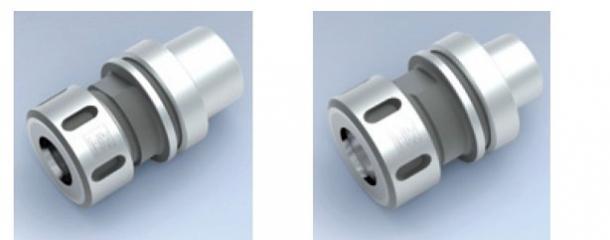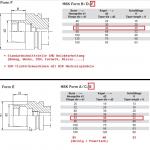HSK-E63Designation for a tool interface with hollow shank taper, which is standardized on the base of DIN 69893. In the area of woodworking, the HSK interface has replaced the previously widespread steep-angle taper since the end of the 1990s.
Hollow shank tapers are approximately 30 % smaller and approx. 50 % lighter than steep-angle tapers. They have a higher stiffness, caused by its construction, and due to optimal locating surfaces also a higher position accuracy. Hollow shank tapers can be used for higher rpm, because the clamping force increases by increasing centrifugal force. Clamping bolts are not necessary.
In the area of woodworking, the hollow shank taper HSK-E63 was introduced in the end of the 2000s. It has a much higher taper surface than the shape of the HSK-F63 and is able to transfer nearly the double torque. Thus, the collar is a lot smaller and therefore also the axial contact surface. It is used in machines, where heavy tools are used, especially window construction systems. The standard clamping system in the woodworking area is still the hollow shank taper HSK-F63. Alternative terms
See also |
CNC machining centres, robots894
Edgebanding, edge processing629
Saws, cutting machines439
Planers, 4-sided moulders188
Routers, shapers, tenoners, profilers181
Drilling, mortising machines135
Presses, clamps, joining machines202
Sanding machines320
Mechanisation, storage, packing technology200
Surface coating152
Production lines127
Heating, drying, waste chopping62
Dust extraction, compressed air, vacuum134
Assembly, worktables15
Lathes29
Tools, sharpening technology91
Equipment, Other machines131


